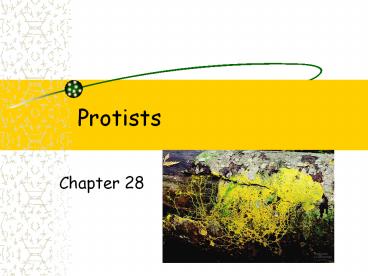Protists - PowerPoint PPT Presentation
1 / 60
Title:
Protists
Description:
Protists Chapter 28 – PowerPoint PPT presentation
Number of Views:165
Avg rating:3.0/5.0
Title: Protists
1
Protists
- Chapter 28
2
Protists
- Eukaryotes
- Not plants, fungi or animals
3
Protists
- Unicellular
- Colonial Multi-cellular
- Highly variable
- No one unifying feature
- protist informal term
- Greatest diversity of eukaryotic kingdoms.
4
Endosymbiosis
Plastid
Dinoflagellates
Secondary endosymbiosis
Apicomplexans
Red alga
Cyanobacterium
Primary endosymbiosis
Stramenopiles
Plastid
Heterotrophic eukaryote
Secondary endosymbiosis
Over the course of evolution, this membrane was
lost.
Euglenids
Secondary endosymbiosis
Green alga
Chlorarachniophytes
5
General biology
- Cell surface
- Locomotion organelles
- Cyst formation
- Nutrition
- Reproduction
6
Cell surface
- Varies
- Only cell membrane
- Extra cellular material (ECM) on outside of
membrane - ECM makes a strong cell wall
- Diatoms shells of silica
7
Locomotion organelles
- Varies
- Flagella (1 or more)
- Several shorter called cilia
- Pseudopodial (false feet)
- Lobopodia-blunt extensions
- Filopodia-thin branch extensions
- Axopodia-supported by microtubules
8
Cyst formation
- Protective covering
- In adverse environments
- Dormant forms
9
Nutrition
- Phototrophs (photosynthetic)
- Heterotrophs
- Mixotrophs
- Combine photosynthesis with heterotrophic
nutrition - Phagotrophs
- Ingest visible particles of food
- Osomotrophs
- Ingest soluble food
10
Reproduction
- Asexually
- Binary fission
- Budding
- Sexual reproduction
- Gamete meiosis
- Spore-producing protists are haploid as adults
- Algae alternate haploid/diploid
11
Fig. 28-23
RESULTS
Choanoflagellates
Animals
Unikonta
Fungi
Common ancestor of all eukaryotes
Amoebozoans
Diplomonads
Excavata
Euglenozoans
Alveolates
Chromalveolata
Stramenopiles
DHFR-TS gene fusion
Rhizaria
Rhizarians
Red algae
Green algae
Archaeplastida
Plants
12
Categories
- 1. Excavata
- 2. Chromalveolata
- 3. Rhizaria
- 4. Archaeplastida
- 5. Unikonta
13
1. Excavata
- Diplomonads
- Parabasalids
- Euglenozoans
- CDC
14
Diplomonads
- Giardia lamblia (parasite)
- Flagellate protist
- Mitochondria lacking DNA, ETC or enzymes for
citric acid cycle - Anaerobic environment
- Found in water
- Cause diarrhea
- hikers diarrhea
15
Parabasalids
- Trichomonads
- Reduced mitochondria
- Anaerobic energy production
- T. vaginalis
- Infects vaginal lining
- Disrupts normal acidity of vagina
16
Euglenozoans
- Euglenoids
- Mixotrophs
- Earliest free-living eukaryotes
- Fresh water
- Move by flagellum
- Asexually
17
Euglena
18
(No Transcript)
19
Euglenozoan
- Kinetoplastids
- Single mitochondria
- 2 types of DNA
- Parasites
- Typanosomiasis
- African sleeping disease
20
2. Chromalveoletes
- Alevolates
- Dinoflagellates
- Apicomplexans
- Ciliates
- Stramenopiles
- Diatoms
- Golden algae
- Brown algae
- Oomycetes
21
Dinoflagellates
22
Alveolata
- Common trait
- Alveoli (membrane sac)
- Space below plasma membrane
23
Dinoflagellates
- Photosynthetic
- Marine freshwater
- Characteristic shape
- Reinforced by internal plates of cellulose.
- Two flagella sit in perpendicular grooves in the
armor - Produce a spinning movement
- red tide produced with large growth
24
Apicomplexes
- Spore forming parasites
- Spores pass from host to host
- Apical complexes
- Organelles-one of cell
- Plasmodium causes malaria
- Mosquito to human
25
Plasmodium
26
Malaria
27
Toxoplasma gondi
28
Ciliates
- Large numbers of cilia
- Anchored to microtubules below membrane
- 2 nuclei
- Macronucleus for mitosis
- Micronucleus for sexual reproduction
29
Paramecium
30
Paramecium
31
Ciliates
32
Paramecium
33
Stramenopila
- Diatoms
- Brown algae
- Golden algae
- Oomycetes
34
Diatoms
- Unique glasslike walls
- Hydrated silica in an organic matrix.
- Overlap like a shoe box lid.
- Photosynthetic
- Mostly unicellular
35
Diatoms
36
Brown algae
- Largest algae (kelp)
- Multicellular
- Most are marine
- Found in cooler waters
- Color due to carotenoids
- Alternate between diploid haploid cycles
- Thickens foods (ice cream, pudding)
37
Brown algae
38
Golden algae (Chrysophyta),
- Named for the yellow brown carotene
- Xanthophyll pigments
- Typically bi-flagellated.
- Many freshwater
- Most are unicellular, some are colonial.
- Poor environment
- Form resistant cysts-viable for decades.
39
Golden algae (Chrysophyta),
40
Oomycetes
- Cellulose in cell walls
- Mostly diploid
- Flagellated cells
- Caused the potato blight in 1845-47
- Turned potato plants to black slime
41
3. Rhizaria
- Amoebas
- Forams
- Radiolarians
42
Amoebas
- Pseudopods
- Flowing extension of cytoplasm
- Pulls amoeba forward
- Causes dysentery
43
Amoebas
44
Forams
- Almost all marine.
- Most live in sand or attach to rocks or algae.
- Some are in plankton.
- Multi-chambered, porous shells
- Consists of organic materials
- Hardened with calcium carbonate
- Tests
45
Forams
46
Radiolarians
- Marine
- Internal skeleton made of silica
- Skeleton lines seafloor when dies
47
Radiolarians
200 µm
48
4. Archaeplastida
- Red algae
- Green algae
49
Rhodophyta
- Red algae
- Microscopic to large seaweed on beach
- Mostly multi-cellular
- Warm coastal waters
- Used in sushi
50
Red algae
51
Chlorophyta
- Green algae
- Green chloroplasts
- Similar to plants
- Diverged recently
- Mostly live in fresh water
- Unicellular to multi-cellular
52
Green algae
53
5. Unikonta
- Slime molds
- Choanoflagellida
54
Slime molds
- Looks like a moving mass of slime
- Plasmodium
- A multinucleated mass of cytoplasm
- Move as a mass called a slug
- Digest bacteria, yeasts other small organic
particles - Multi-cellular unicellular
55
Slim molds
56
Slim molds
57
Slim molds
58
Slim mold
59
Choanoflagellida
- Similar to sponges
- Freshwater
- Single flagellum
- Feed on bacteria
60
Fig. 28-UN6































